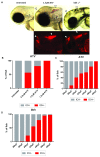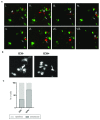Using zebrafish larval models to study brain injury, locomotor and neuroinflammatory outcomes following intracerebral haemorrhage
- PMID: 30473780
- PMCID: PMC6234746
- DOI: 10.12688/f1000research.16473.2
Using zebrafish larval models to study brain injury, locomotor and neuroinflammatory outcomes following intracerebral haemorrhage
Abstract
Intracerebral haemorrhage (ICH) is a devastating condition with limited treatment options, and current understanding of pathophysiology is incomplete. Spontaneous cerebral bleeding is a characteristic of the human condition that has proven difficult to recapitulate in existing pre-clinical rodent models. Zebrafish larvae are frequently used as vertebrate disease models and are associated with several advantages, including high fecundity, optical translucency and non-protected status prior to 5 days post-fertilisation. Furthermore, other groups have shown that zebrafish larvae can exhibit spontaneous ICH. The aim of this study was to investigate whether such models can be utilised to study the pathological consequences of bleeding in the brain, in the context of pre-clinical ICH research. Here, we compared existing genetic (bubblehead) and chemically inducible (atorvastatin) zebrafish larval models of spontaneous ICH and studied the subsequent disease processes. Through live, non-invasive imaging of transgenic fluorescent reporter lines and behavioural assessment we quantified brain injury, locomotor function and neuroinflammation following ICH. We show that ICH in both zebrafish larval models is comparable in timing, frequency and location. ICH results in increased brain cell death and a persistent locomotor deficit. Additionally, in haemorrhaged larvae we observed a significant increase in macrophage recruitment to the site of injury. Live in vivo imaging allowed us to track active macrophage-based phagocytosis of dying brain cells 24 hours after haemorrhage. Morphological analyses and quantification indicated that an increase in overall macrophage activation occurs in the haemorrhaged brain. Our study shows that in zebrafish larvae, bleeding in the brain induces quantifiable phenotypic outcomes that mimic key features of human ICH. We hope that this methodology will enable the pre-clinical ICH community to adopt the zebrafish larval model as an alternative to rodents, supporting future high throughput drug screening and as a complementary approach to elucidating crucial mechanisms associated with ICH pathophysiology.
Keywords: Intracerebral haemorrhage; animal models; neuroinflammation; pre-clinical; zebrafish.
Conflict of interest statement
No competing interests were disclosed.
Figures






References
-
- ASPA 1986 amendments 2012: Animals (Scientific Procedures) Act 1986. Reference Source
Publication types
Grants and funding
LinkOut - more resources
Full Text Sources
Molecular Biology Databases

